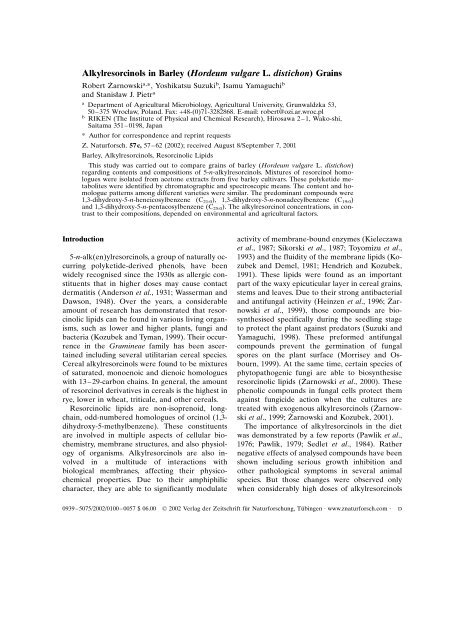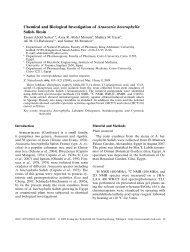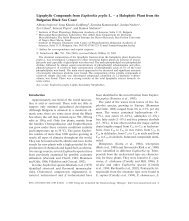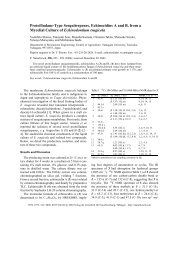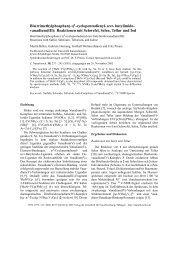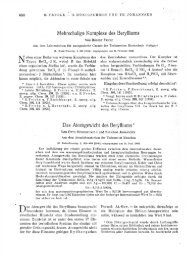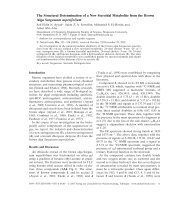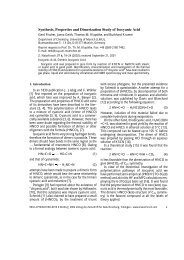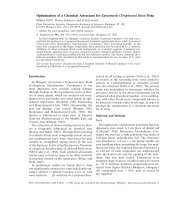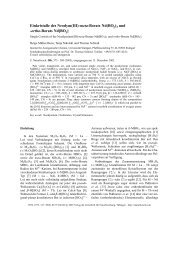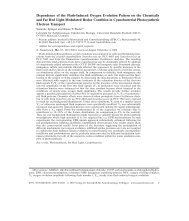Alkylresorcinols in Barley (Hordeum vulgare L. distichon) Grains
Alkylresorcinols in Barley (Hordeum vulgare L. distichon) Grains
Alkylresorcinols in Barley (Hordeum vulgare L. distichon) Grains
Create successful ePaper yourself
Turn your PDF publications into a flip-book with our unique Google optimized e-Paper software.
<strong>Alkylresorc<strong>in</strong>ols</strong> <strong>in</strong> <strong>Barley</strong> (<strong>Hordeum</strong> <strong>vulgare</strong> L. <strong>distichon</strong>) Gra<strong>in</strong>s<br />
Robert Z˙ arnowski a, *, Yoshikatsu Suzuki b , Isamu Yamaguchi b<br />
and Stanisław J. Pietr a<br />
a Department of Agricultural Microbiology, Agricultural University, Grunwaldzka 53,<br />
50Ð375 Wrocław, Poland. Fax: +48-(0)71-3282868. E-mail: robert@ozi.ar.wroc.pl<br />
b RIKEN (The Institute of Physical and Chemical Research), Hirosawa 2Ð1, Wako-shi,<br />
Saitama 351Ð0198, Japan<br />
* Author for correspondence and repr<strong>in</strong>t requests<br />
Z. Naturforsch. 57c, 57Ð62 (2002); received August 8/September 7, 2001<br />
<strong>Barley</strong>, <strong>Alkylresorc<strong>in</strong>ols</strong>, Resorc<strong>in</strong>olic Lipids<br />
This study was carried out to compare gra<strong>in</strong>s of barley (<strong>Hordeum</strong> <strong>vulgare</strong> L. <strong>distichon</strong>)<br />
regard<strong>in</strong>g contents and compositions of 5-n-alkylresorc<strong>in</strong>ols. Mixtures of resorc<strong>in</strong>ol homologues<br />
were isolated from acetone extracts from five barley cultivars. These polyketide metabolites<br />
were identified by chromatographic and spectroscopic means. The content and homologue<br />
patterns among different varieties were similar. The predom<strong>in</strong>ant compounds were<br />
1,3-dihydroxy-5-n-heneicosylbenzene (C21:0), 1,3-dihydroxy-5-n-nonadecylbenzene (C19:0) and 1,3-dihydroxy-5-n-pentacosylbenzene (C25:0). The alkylresorc<strong>in</strong>ol concentrations, <strong>in</strong> contrast<br />
to their compositions, depended on environmental and agricultural factors.<br />
Introduction<br />
5-n-alk(en)ylresorc<strong>in</strong>ols, a group of naturally occurr<strong>in</strong>g<br />
polyketide-derived phenols, have been<br />
widely recognised s<strong>in</strong>ce the 1930s as allergic constituents<br />
that <strong>in</strong> higher doses may cause contact<br />
dermatitis (Anderson et al., 1931; Wasserman and<br />
Dawson, 1948). Over the years, a considerable<br />
amount of research has demonstrated that resorc<strong>in</strong>olic<br />
lipids can be found <strong>in</strong> various liv<strong>in</strong>g organisms,<br />
such as lower and higher plants, fungi and<br />
bacteria (Kozubek and Tyman, 1999). Their occurrence<br />
<strong>in</strong> the Gram<strong>in</strong>eae family has been ascerta<strong>in</strong>ed<br />
<strong>in</strong>clud<strong>in</strong>g several utilitarian cereal species.<br />
Cereal alkylresorc<strong>in</strong>ols were found to be mixtures<br />
of saturated, monoenoic and dienoic homologues<br />
with 13Ð29-carbon cha<strong>in</strong>s. In general, the amount<br />
of resorc<strong>in</strong>ol derivatives <strong>in</strong> cereals is the highest <strong>in</strong><br />
rye, lower <strong>in</strong> wheat, triticale, and other cereals.<br />
Resorc<strong>in</strong>olic lipids are non-isoprenoid, longcha<strong>in</strong>,<br />
odd-numbered homologues of orc<strong>in</strong>ol (1,3dihydroxy-5-methylbenzene).<br />
These constituents<br />
are <strong>in</strong>volved <strong>in</strong> multiple aspects of cellular biochemistry,<br />
membrane structures, and also physiology<br />
of organisms. <strong>Alkylresorc<strong>in</strong>ols</strong> are also <strong>in</strong>volved<br />
<strong>in</strong> a multitude of <strong>in</strong>teractions with<br />
biological membranes, affect<strong>in</strong>g their physicochemical<br />
properties. Due to their amphiphilic<br />
character, they are able to significantly modulate<br />
activity of membrane-bound enzymes (Kieleczawa<br />
et al., 1987; Sikorski et al., 1987; Toyomizu et al.,<br />
1993) and the fluidity of the membrane lipids (Kozubek<br />
and Demel, 1981; Hendrich and Kozubek,<br />
1991). These lipids were found as an important<br />
part of the waxy epicuticular layer <strong>in</strong> cereal gra<strong>in</strong>s,<br />
stems and leaves. Due to their strong antibacterial<br />
and antifungal activity (He<strong>in</strong>zen et al., 1996; Z˙ arnowski<br />
et al., 1999), those compounds are biosynthesised<br />
specifically dur<strong>in</strong>g the seedl<strong>in</strong>g stage<br />
to protect the plant aga<strong>in</strong>st predators (Suzuki and<br />
Yamaguchi, 1998). These preformed antifungal<br />
compounds prevent the germ<strong>in</strong>ation of fungal<br />
spores on the plant surface (Morrisey and Osbourn,<br />
1999). At the same time, certa<strong>in</strong> species of<br />
phytopathogenic fungi are able to biosynthesise<br />
resorc<strong>in</strong>olic lipids (Z˙ arnowski et al., 2000). These<br />
phenolic compounds <strong>in</strong> fungal cells protect them<br />
aga<strong>in</strong>st fungicide action when the cultures are<br />
treated with exogenous alkylresorc<strong>in</strong>ols (Z˙ arnowski<br />
et al., 1999; Z˙ arnowski and Kozubek, 2001).<br />
The importance of alkylresorc<strong>in</strong>ols <strong>in</strong> the diet<br />
was demonstrated by a few reports (Pawlik et al.,<br />
1976; Pawlik, 1979; Sedlet et al., 1984). Rather<br />
negative effects of analysed compounds have been<br />
shown <strong>in</strong>clud<strong>in</strong>g serious growth <strong>in</strong>hibition and<br />
other pathological symptoms <strong>in</strong> several animal<br />
species. But those changes were observed only<br />
when considerably high doses of alkylresorc<strong>in</strong>ols<br />
0939Ð5075/2002/0100Ð0057 $ 06.00 ” 2002 Verlag der Zeitschrift für Naturforschung, Tüb<strong>in</strong>gen · www.znaturforsch.com · D
58 R. Zarnowski et al. · Alkylresorc<strong>in</strong>olds from <strong>Barley</strong><br />
were applied. Until now, however, there are no<br />
established toxicity levels of alkylresorc<strong>in</strong>ols<br />
aga<strong>in</strong>st mammalian organisms. On the contrary, <strong>in</strong><br />
vitro studies on biological activities of alkylresorc<strong>in</strong>ols<br />
<strong>in</strong>dicated their strong antitumor action<br />
aga<strong>in</strong>st certa<strong>in</strong> cancer cell l<strong>in</strong>es (Itokawa et al.,<br />
1989; Matsumoto et al., 1990). Moreover, alkylresorc<strong>in</strong>ols<br />
exhibit the ability to protect cellular lipid<br />
components aga<strong>in</strong>st oxidation processes (Kozubek<br />
and Tyman, 1999). Lack of toxic and carc<strong>in</strong>ogenic<br />
effects of alkylresorc<strong>in</strong>ols together with their antioxidant<br />
and antitumor properties suggests their<br />
possible participation <strong>in</strong> the protection of cells<br />
aga<strong>in</strong>st cancer disorders.<br />
Human population of today is concerned about<br />
hav<strong>in</strong>g an adequate amount of fibres <strong>in</strong> the diet.<br />
It should be noted that various high fibre products<br />
conta<strong>in</strong> up to a three-fold higher concentration of<br />
alkylresorc<strong>in</strong>ols than the rye gra<strong>in</strong>s (Al-Ruqaie<br />
and Lorenz, 1992). Therefore, the consumption of<br />
these products might exert positive effects on human<br />
health.<br />
The objective of this study was to determ<strong>in</strong>e alkylresorc<strong>in</strong>ol<br />
content and homologue composition<br />
among <strong>in</strong>vestigated barley cultivars to estimate the<br />
usefulness of those cultivars from the nutritional<br />
po<strong>in</strong>t of view.<br />
Experimental<br />
Gra<strong>in</strong> samples<br />
Five qualified varieties of spr<strong>in</strong>g-crop barley<br />
(<strong>Hordeum</strong> <strong>vulgare</strong> L. <strong>distichon</strong>), cv. Rabel, cv.<br />
Rambo, cv. Rataj, cv. Rudzik, and cv. Scarlett,<br />
were studied. All varieties were cultivated on field<br />
plots at the Wrocław Agricultural University Plant<br />
Cultivation Experimental Station <strong>in</strong> Pawłowice,<br />
Poland. Complete cultivar vouchers are available<br />
from the Central Laboratory for Studies of Cultivable<br />
Plants (COBORU), Słupia Wielka, Poland.<br />
Plant material was harvested <strong>in</strong> 1998, except cv.<br />
Rudzik, which was collected <strong>in</strong> 1998 as well as <strong>in</strong><br />
1999. Gra<strong>in</strong>s were collected when the full maturity<br />
was achieved and then kept <strong>in</strong> moisture-proof conta<strong>in</strong>ers<br />
until further laboratory analyses.<br />
Isolation and purification of alkylresorc<strong>in</strong>ols<br />
The fraction of resorc<strong>in</strong>olic lipids was isolated<br />
from whole gra<strong>in</strong>s, except gra<strong>in</strong>s of cv. Rudzik har-<br />
vested <strong>in</strong> 1998. Part of this sample (whole gra<strong>in</strong>s)<br />
was ground previously <strong>in</strong> a laboratory mill. From<br />
each gra<strong>in</strong> sample, 30 g was soaked completely at<br />
room temperature with an equal amount of acetone.<br />
After 24 hrs, the acetone fraction was filtered<br />
through filter paper to remove any solid particles.<br />
The filtrate was saved and the plant material was<br />
soaked twice more with the same amount of acetone<br />
for 24 hrs each. All acetone filtrates were<br />
comb<strong>in</strong>ed and the solvent was removed by vacuum<br />
evaporation on a rotavapor at 40 ∞C. The oily residue<br />
was redissolved <strong>in</strong> 0.2 ml of ethyl acetate and<br />
then applied on a 20 ¥ 20 cm preparative TLC<br />
silica gel 60. Separation was carried out by chloroform/ethyl<br />
acetate (85:15, v/v). Afterwards, 1 cm<br />
wide strips of the gel on both sides of the plate<br />
were sprayed with aqueous 0.05% Fast Blue B ¥<br />
BF 4 (Chemapol, Prague, Czech Republic). <strong>Alkylresorc<strong>in</strong>ols</strong><br />
were identified by their characteristic<br />
reddish-violet colour and R f value (Kozubek and<br />
Tyman, 1995). Parts of the gel conta<strong>in</strong><strong>in</strong>g compounds<br />
of <strong>in</strong>terest were scraped off the plates and<br />
the material was extracted with ethyl acetate dur<strong>in</strong>g<br />
occasional shak<strong>in</strong>g for 2 hrs. After centrifugation<br />
(7500 ¥g, 10 m<strong>in</strong>), the supernatant was decanted<br />
and the rema<strong>in</strong><strong>in</strong>g gel extracted once aga<strong>in</strong>.<br />
All supernatants were comb<strong>in</strong>ed, concentrated <strong>in</strong><br />
vacuo and then redissolved <strong>in</strong> 0.2 ml of ethyl acetate.<br />
The solution was applied on a similar preparative<br />
TLC plate and the chromatogram was developed<br />
by hexane/ethyl ether/formic acid (70:30:1, v/<br />
v). Next steps for resorc<strong>in</strong>ols separation, gel sta<strong>in</strong><strong>in</strong>g<br />
and its extraction, centrifugation, and concentration,<br />
were repeated. The fraction of pure alkylresorc<strong>in</strong>ols<br />
was redissolved <strong>in</strong> 0.2 ml of chloroform<br />
and used for further analysis. Each of the isolations<br />
was made at least <strong>in</strong> triplicate.<br />
Determ<strong>in</strong>ation ofalkylresorc<strong>in</strong>ols content<br />
The microcolorimetric method (Tłus´cik et al.,<br />
1981) was used for quantitative determ<strong>in</strong>ation of<br />
alkylresorc<strong>in</strong>ols <strong>in</strong> analysed plant material. Briefly,<br />
the sample conta<strong>in</strong><strong>in</strong>g compounds of <strong>in</strong>terest, dissolved<br />
<strong>in</strong> chloroform was put <strong>in</strong>to a dry glass tube<br />
and the solvent evaporated with a stream of nitrogen<br />
gas. To the dry residue 4 ml of the reagent<br />
prepared by a 5-fold dilution with n-propanol of<br />
0.05% (w/v) Fast Blue B ¥ BF 4 <strong>in</strong> 5% acetic acid<br />
were added. The content was thoroughly mixed
R. Zarnowski et al. · Alkylresorc<strong>in</strong>olds from <strong>Barley</strong> 59<br />
us<strong>in</strong>g a Vortex mixer and left <strong>in</strong> the dark for an<br />
hour. The sample was read at 520 nm aga<strong>in</strong>st the<br />
reagent blank. The content of alkylresorc<strong>in</strong>ols was<br />
estimated us<strong>in</strong>g a calibration curve (1Ð10 µg) prepared<br />
by a suitably diluted stock solution of<br />
recrystallized pure 5-n-pentadecylresorc<strong>in</strong>ol (Aldrich<br />
Chemical Co., Milwaukee, WI) as reference<br />
compound. Each determ<strong>in</strong>ation was carried out<br />
<strong>in</strong> triplicate.<br />
<strong>Alkylresorc<strong>in</strong>ols</strong> homologue composition<br />
The sample conta<strong>in</strong><strong>in</strong>g alkylresorc<strong>in</strong>ols mixture<br />
was re-dissolved <strong>in</strong> 100 µl of ethyl acetate. 70 µl of<br />
the sample was added <strong>in</strong>to a glass capillary-tube<br />
(ø ca. 2 mm, 5 cm). After removal of the solvent,<br />
5 µl of N-methyl-N-trimethylsilyltrifluoroacetimide<br />
(MSTFA) was added and the tube was sealed<br />
and allowed to stand at 70 ∞C for 30 m<strong>in</strong>. One µlof<br />
the derivatized sample was <strong>in</strong>jected <strong>in</strong>to HP 5890<br />
Series II gas chromatograph connected to JEOL<br />
SX-102A mass spectrometer, at 70 eV with a gas<br />
flow rate of 1 ml/m<strong>in</strong> of He. A DB-1 column (G &<br />
L Science, Tokyo, Japan; ø 0.25 mm ¥ 15 m, 0.25<br />
µm film thickness) was used and column oven<br />
temperature was programmed as follows: 130 ∞C<br />
for 1 m<strong>in</strong>, 30 ∞C/m<strong>in</strong> to 250, 15 ∞C/m<strong>in</strong> up to 320<br />
and 320 ∞C for 2 m<strong>in</strong>. Sample <strong>in</strong>jection was at<br />
250 ∞C. Identification of each alkylresorc<strong>in</strong>ol homologue<br />
was obta<strong>in</strong>ed from the molecular ion and<br />
common base peak ion at m/z 268 which is characteristic<br />
of these molecules. The retention time of<br />
each homologue was 9.3 m<strong>in</strong> (M + 464, C15:0), 10.4 m<strong>in</strong> (M + 492, C17:0), 11.6 m<strong>in</strong> (M + 520, C19:0), 12.7 m<strong>in</strong> (M + 548, C21:0), 13.8 m<strong>in</strong> (M + 576, C23:0) and 14.9 m<strong>in</strong> (M + 604, C25:0), respectively. The relative<br />
composition and total amounts of the homologue<br />
were estimated by the area of the base peak<br />
ion at m/z 268.<br />
Chromatographic analyses<br />
Additional identification of resorc<strong>in</strong>olic lipids<br />
was carried out us<strong>in</strong>g a set of chromatographic<br />
techniques. Normal-phase TLC separations were<br />
done on analytical and preparative layers on plastic<br />
and glass plates covered with silica gel Si60.<br />
After development of chromatograms and evaporation<br />
of solvents, the plates were sprayed with<br />
aqueous 0.05% Fast Blue B ¥ BF4 and alkylresorc<strong>in</strong>ols<br />
were identified by their characteristic red-<br />
dish-violet colour and R f value. To determ<strong>in</strong>e composition<br />
of the homologues accord<strong>in</strong>g to the length<br />
of the side cha<strong>in</strong>, reversed-phase TLC on RP18<br />
HPTLC plates (Kozubek, 1985) and normal-phase<br />
TLC on alum<strong>in</strong>ium oxide (Tłus´cik and Kozubek,<br />
1984) were used. The presence and composition of<br />
homologues accord<strong>in</strong>g to their unsaturation were<br />
determ<strong>in</strong>ed by argentation chromatography on silica<br />
gel impregnated with 5% AgNO 3 (Kaczmarek<br />
and Tłus´cik, 1984). All TLC plates were from<br />
Merck (Darmstadt, Germany). Solvents and reagents<br />
of highest available purity were from Polskie<br />
Odczynniki Chemiczne (Gliwice, Poland).<br />
Results<br />
Five different cultivars of barley were analysed<br />
for content and composition of resorc<strong>in</strong>olic lipids.<br />
Crude acetone extracts from dry mature gra<strong>in</strong>s<br />
were separated by TLC on silica gel developed<br />
with chloroform/ethyl acetate (85:15, v/v) mixture.<br />
Such purified alkylresorc<strong>in</strong>ols’ fractions were<br />
identified on TLC plates by their specific reddishviolet<br />
colour <strong>in</strong> reaction with diazonic salt Fast<br />
Blue B and their very characteristic mobility value<br />
(R f), identical to authentic 5-n-pentadecylresorc<strong>in</strong>ol.<br />
The content of resorc<strong>in</strong>olic lipids was determ<strong>in</strong>ed<br />
<strong>in</strong> purified fractions. Quantitation of alkylresorc<strong>in</strong>ols<br />
<strong>in</strong> analyzed samples was done measur<strong>in</strong>g<br />
the difference of absorbance of the colour<br />
complex between tested compounds and the diazonic<br />
salt. Quantitation <strong>in</strong> whole lipid extracts is<br />
an <strong>in</strong>advisable method due to the presence of<br />
other non-resorc<strong>in</strong>olic substances cross-react<strong>in</strong>g<br />
with Fast Blue B. Extracts from each analysed<br />
sample should be first purified to remove contam<strong>in</strong>at<strong>in</strong>g<br />
components. Calculated values of alkylresorc<strong>in</strong>ols<br />
content are summarised <strong>in</strong> Table I.<br />
Eight resorc<strong>in</strong>ol homologues diverse regard<strong>in</strong>g<br />
their length of side-carbon cha<strong>in</strong>s as well as their<br />
(un)saturation, were found. The qualitative and<br />
quantitative patterns of homologues <strong>in</strong> different<br />
cultivars were rather similar. Regardless of the<br />
variety, the predom<strong>in</strong>ant compounds found were<br />
1,3-dihydroxy-5-n-heneicosylbenzene (C 21:0 Ð ca.<br />
40%), 1,3-dihydroxy-nonadecylbenzene (C 19:0 Ð<br />
ca. 29%), 1,3-dihydroxy-5-n-pentacosylbenzene<br />
(C 25:0 Ð ca. 19%), and 1,3-dihydroxy-tricosylbenzene<br />
(C 23:0 Ð ca. 11%). Only spurious amounts of
60 R. Zarnowski et al. · Alkylresorc<strong>in</strong>olds from <strong>Barley</strong><br />
Table I. <strong>Alkylresorc<strong>in</strong>ols</strong> <strong>in</strong> barley gra<strong>in</strong>s.<br />
Homologue composition<br />
Cultivar Year of Content d (% of total alkylresorc<strong>in</strong>ol content)<br />
harvest [mg/kg]<br />
C 15:0 C 17:0 C 19:0 C 19:1 C 21:0 C 21:1 C 23:0 C 25:0<br />
Rabel 1998 54.1 0.1 1.2 27.2 0.1 39.9 t 11.0 20.7<br />
Rambo 1998 41.1 0.2 1.6 29.9 0.4 42.5 t 10.9 14.9<br />
Rataj 1998 47.0 0.2 1.6 29.0 0.5 41.8 0.1 11.7 15.9<br />
Scarlett 1998 44.1 1.2 2.0 31.3 0.6 42.8 t 10.1 12.5<br />
Rudzik 1998 43.4 nd nd 25.0 nd 37.6 nd 12.9 24.5<br />
Rudzik g 1998 209.9 nd nd 24.4 nd 38.7 nd 12.6 24.3<br />
Rudzik 1999 73.9 nd 3.2 36.5 t 34.0 nd 8.2 18.2<br />
g Ð ground before laboratory process<strong>in</strong>g; d Ð dry weight; t Ð trace; nd Ð not detectable; R: C15Ð25 saturated or<br />
monounsaturated side cha<strong>in</strong>.<br />
1,3-dihydroxy-5-n-heptadecylbenzene (C 17:0) and<br />
of 1,3-dihydroxy-5-n-pentadecylbenzene (C 15:0),<br />
were found. Similarly, the content of monounsaturated<br />
homologues was very low, whereas diunsaturated<br />
resorc<strong>in</strong>ol derivatives were not found.<br />
The analysis of alkylresorc<strong>in</strong>ols provided apparent<br />
evidence on their basic skeletal structure, regard<strong>in</strong>g<br />
their alkyl cha<strong>in</strong> length as well as the cha<strong>in</strong><br />
unsaturation degree. The unambiguous identification<br />
of those analyzed compounds was disclosed<br />
by the occurrence of characteristic base ionic<br />
peaks at m/z 267 and 268 and their mutual ratio<br />
1:4 or 1:5 (V<strong>in</strong>cieri et al., 1981). The same homologues<br />
were recognised us<strong>in</strong>g mass spectrometry<br />
as well as reversed- and normal-phase TLC techniques.<br />
Next, the application of the argentation<br />
chromatography allowed establish<strong>in</strong>g homologue<br />
compositions diverse <strong>in</strong> saturation of the sidecha<strong>in</strong>.<br />
It was found that all analysed barley varieties<br />
conta<strong>in</strong>ed mostly saturated homologues and<br />
only trace amounts of monounsaturated homologues.<br />
Collected data are presented <strong>in</strong> Table I.<br />
Discussion<br />
In this report, we demonstrated the content and<br />
composition of resorc<strong>in</strong>olic lipids <strong>in</strong> gra<strong>in</strong>s of five<br />
barley cultivars. We found that cv. Rabel, cv.<br />
Rambo, cv. Rataj, cv. Scarlet and cv. Rudzik conta<strong>in</strong><br />
similar amounts of alk(en)ylresorc<strong>in</strong>ols, up to<br />
54 mg per kilogram (dry weight). Consequently,<br />
they may be classified as the group of low-resorc<strong>in</strong>ol<br />
varieties.<br />
The comparison of resorc<strong>in</strong>olic lipids’ contents<br />
<strong>in</strong> milled and whole gra<strong>in</strong>s of cv. Rudzik showed<br />
some differences. We found that extraction from<br />
milled whole gra<strong>in</strong>s yielded nearly 4.8 times<br />
higher amount than from whole gra<strong>in</strong>s. Thereby,<br />
it suggests that the majority of these compounds<br />
is localised <strong>in</strong> the epiculticular wax zone (about<br />
20%). This result is <strong>in</strong> good agreement with the<br />
prior report on localisation of alkylresorc<strong>in</strong>ols <strong>in</strong><br />
cereals (Verdeal and Lorenz, 1977; Tłus´cik, 1978;<br />
Salek, 1978), which showed bran to conta<strong>in</strong> the<br />
highest alkylresorc<strong>in</strong>ol level. Intermediate values<br />
were found <strong>in</strong> the shorts, whereas the flour fractions<br />
produced relative low values. This <strong>in</strong>dicates<br />
that a gradient exists with the highest amount<br />
of the compounds <strong>in</strong> the pericarp, <strong>in</strong>termediate<br />
amounts <strong>in</strong> the aleurone layer, and relatively<br />
small but detectable amounts <strong>in</strong> the endosperm<br />
portion of cereal gra<strong>in</strong> kernels. Our observation<br />
supports also the thesis of the protective role of<br />
these phenols <strong>in</strong> gra<strong>in</strong> biology (Suzuki et al.,<br />
1996). This assumption seems to be correct, the<br />
more so because it was earlier found that lowresorc<strong>in</strong>ol<br />
cereal cultivars are more susceptible<br />
to fungal <strong>in</strong>fections (García et al., 1997; Z˙ arnowski<br />
and Pietr, unpublished). There was also found<br />
that pathogenic microorganisms more often <strong>in</strong>fect<br />
gra<strong>in</strong>s <strong>in</strong> damaged places. Additionally, the<br />
legitimacy of this thesis appears authentic due to<br />
antifungal activities of alk(en)ylresorc<strong>in</strong>ols have<br />
been already reported <strong>in</strong> a few papers (García<br />
et al., 1997; Z˙ arnowski et al., 1999).
R. Zarnowski et al. · Alkylresorc<strong>in</strong>olds from <strong>Barley</strong> 61<br />
In this paper, the fluctuation of alkylresorc<strong>in</strong>ols<br />
content dur<strong>in</strong>g consecutive followed vegetation<br />
periods has been also reported. We stated that<br />
amounts of alkylresorc<strong>in</strong>ols <strong>in</strong> gra<strong>in</strong>s of cv. Rudzik<br />
were diverse <strong>in</strong> 1998 and 1999. Plants were<br />
cropped on the same field plots, so this observed<br />
variability undoubtedly is directly affected by environmental<br />
factors, such as climatic conditions,<br />
weather, and fertilisation. This f<strong>in</strong>d<strong>in</strong>g is <strong>in</strong> a good<br />
agreement to the data of Wier<strong>in</strong>ga (1987). Besides,<br />
Al-Ruqaie and Lorenz (1992) reported that cereal<br />
gra<strong>in</strong>s grown under the same agronomic and cli-<br />
matic conditions dur<strong>in</strong>g consecutive crop years<br />
showed only slight variations from year to year.<br />
Acknowledgements<br />
RZ˙ and YS contributed to this work equally. RZ˙<br />
is deeply <strong>in</strong>debted to the Foundation for Polish<br />
Science for the National Scholarship for Young<br />
Scientists (Edition 2001). We would like to thank<br />
an anonymous reviewer as well as all those colleagues,<br />
who read this manuscript for their valuable<br />
comments.<br />
Al-Ruqaie I. and Lorenz K. (1992), <strong>Alkylresorc<strong>in</strong>ols</strong> <strong>in</strong> Kozubek A. and Demel R. A. (1981), The effect of 5-(nextruded<br />
cereal brans. Cereal Chem. 69, 472Ð475. alk(en)yl)resorc<strong>in</strong>ols from rye on membrane struc-<br />
Anderson H. H., David N. A. and Leake C. D. (1931), ture. Biochim. Biophys. Acta 642, 242Ð251.<br />
Oral toxicity of certa<strong>in</strong> alkylresorc<strong>in</strong>ols <strong>in</strong> gu<strong>in</strong>ea pigs Kozubek A. and Tyman J. H. P. (1995), Cereal gra<strong>in</strong> resand<br />
rabbits. Proc. Soc. Exp. Biol. Med. 28, 609Ð612. orc<strong>in</strong>olic lipids: mono and dienoic homologues are<br />
García S., García C., He<strong>in</strong>zen H. and Moyna P. (1997), present <strong>in</strong> rye gra<strong>in</strong>s. Chem. Phys. Lipids 78, 29Ð35.<br />
Chemical basis of the resistance of barley seeds to pa- Kozubek A. and Tyman J. H. P. (1999), Resorc<strong>in</strong>olic lipthogenic<br />
fungi. Phytochemistry 44, 415Ð418. ids, the natural non-isoprenoid phenolic amphiphiles<br />
He<strong>in</strong>zen H., Barra C., García C., García S., Larramendi and their biological activity. Chem. Rev. 99, 1Ð26.<br />
S. and Moyna P. (1996), On the chemical ecology of Matsumoto K., Fujimoto M., Ito K., Tanaka H. and Hirepicuticular<br />
waxes from seeds. Proceed<strong>in</strong>gs of the In- ondo I. (1990), Comparison of the effects of bilobol<br />
ternational Society for Chemical Ecology Meet<strong>in</strong>g, and 12-O-tetradecanoylphorbol-13-acetate on sk<strong>in</strong><br />
Prague. Abstract 42. and test of tumor-promot<strong>in</strong>g potential of bilobol <strong>in</strong><br />
Hendrich A. B. and Kozubek A. (1991), Calorimetric CD-1 mice. J. Toxicol. Sci. 15, 39Ð46.<br />
study on the <strong>in</strong>teractions of 5-n-heptadec(en)ylresor- Morrisey J. P. and Osbourn A. E. (1999), Fungal resisc<strong>in</strong>ols<br />
from cereal gra<strong>in</strong>s with zwitterionic phospho- tance to plant antibiotics as a mechanism of pathogenlipid<br />
(DPPC). Z. Naturforsch. 46c, 423Ð427. esis. Microbiol. Mol. Biol. Rev. 63, 708Ð724.<br />
Itokawa H., Totsuka N., Nakahara K., Maezuru M., Ta- Pawlik J. (1979), Growth of chickens as <strong>in</strong>fluenced by<br />
keya K., Kondo, M., Inamatsu M. and Morita H. alkylresorc<strong>in</strong>ols of rye. Rocz. Nauk Zootech. 13,<br />
(1989), A quantitative structure-activity relationship 121Ð136.<br />
for antitumor activity of long-cha<strong>in</strong> phenols from Pawlik J., Kudrewicz-Hubicka Z. and Wilusz T. (1976),<br />
G<strong>in</strong>kgo biloba L. Chem. Pharm. Bull. 37, 1619Ð1621. Growth and dress<strong>in</strong>g percentage of slaughter chicks,<br />
Kaczmarek J. and Tłus´cik F. (1984), Variability of alkylr- and behaviour of their serum prote<strong>in</strong>s as <strong>in</strong>fluenced<br />
esorc<strong>in</strong>ol content <strong>in</strong> rye (Secale cereale L.) gra<strong>in</strong>s. A by rye and the alkylresorc<strong>in</strong>ols conta<strong>in</strong>ed <strong>in</strong> it. Rocz.<br />
comparative analysis with several species of the genus Nauk Zootech. 5, 109Ð125.<br />
Triticum. Genet. Polon. 25, 349Ð358. Salek M. (1978), Determ<strong>in</strong>ation of the 5-alkylresorc<strong>in</strong>ol<br />
Kieleczawa J., Szalewicz A., Kozubek A. and Kulig E. contents <strong>in</strong> rye gra<strong>in</strong> and mill<strong>in</strong>g products. Rocz.<br />
(1987), Effect of resorc<strong>in</strong>ols on electron transport <strong>in</strong> Państ. Zak. Hig. 29, 205Ð211.<br />
pea chloroplasts. Progr. Photosynth. Res. 2, 585Ð587. Sedlet K., Mathias M. and Lorenz K. (1984), Growth-<br />
Kozubek A. (1985), Isolation of 5-n-alkyl, 5-n-alkenyl- depress<strong>in</strong>g effects of 5-n-pentadecylresorc<strong>in</strong>ol: A<br />
and 5-n-alkadienyl-resorc<strong>in</strong>ol homologs from rye model for cereal alkylresorc<strong>in</strong>ols. Cereal Chem. 61,<br />
gra<strong>in</strong>s. Acta Aliment. Polon. 9, 185Ð198. 239Ð241.
62 R. Zarnowski et al. · Alkylresorc<strong>in</strong>olds from <strong>Barley</strong><br />
Sikorski A. F., Michalak K., Bobrowska M. and Kozubek Verdeal K. and Lorenz K. (1977), <strong>Alkylresorc<strong>in</strong>ols</strong> <strong>in</strong><br />
A. (1987), Interaction of spectr<strong>in</strong> with some amphi- wheat, rye and triticale. Cereal Chem. 54, 475Ð483.<br />
patic compounds. Stud. Biophys. 121, 183Ð191. V<strong>in</strong>cieri F. F., V<strong>in</strong>zenz<strong>in</strong>i M. T. and Vanni P. (1981), Ex-<br />
Suzuki Y., Esumi Y., Hyakutake H., Kono Y. and Sa- traction of active compounds from sarcotesta of<br />
kurai A. (1996), Isolation of 5-(8Z-heptadecenyl)- G<strong>in</strong>kgo biloba seeds: <strong>in</strong>hibition of some dehydrogeresorc<strong>in</strong>ol<br />
from etiolated rice seedl<strong>in</strong>gs as an antifun- nase activities. Riv. Ital. E.P. P.O.S. 63, 79Ð82.<br />
gal agent. Phytochemistry 41, 1485Ð1489. Wasserman D. and Dawson R. (1948), Cashew nut-shell<br />
Suzuki Y. and Yamaguchi I. (1998), Antimicrobial agents liquid. III. The cardol component of Indian cashew<br />
(phytoanticip<strong>in</strong>s) <strong>in</strong> Gram<strong>in</strong>eae crops produced speci- nut-shell liquid with reference to the liquid’s vesicant<br />
fically dur<strong>in</strong>g seedl<strong>in</strong>g stage. J. Pest. Sci. 23, 316Ð321. activity. J. Am. Chem. Soc. 70, 3675Ð3679.<br />
Tłus´cik F. (1978), Localization of the alkylresorc<strong>in</strong>ols <strong>in</strong> Wier<strong>in</strong>ga G. W. (1987), On the occurrence of growth <strong>in</strong>rye<br />
and wheat caryopses. Acta Soc. Bot. Polon. 47, hibit<strong>in</strong>g substances <strong>in</strong> rye. PhD dissertation. Wagen-<br />
211Ð218. <strong>in</strong>gen.<br />
Tłus´cik F. and Kozubek A. (1984), Determ<strong>in</strong>ation of ce- Z˙ arnowski R. and Kozubek A. (2001), Resorc<strong>in</strong>olic lipreal<br />
5-n-alkylresorc<strong>in</strong>ol homologs by th<strong>in</strong> layer chro- ids as natural biofungicides. In the Proceed<strong>in</strong>gs of 13 th<br />
matography on alum<strong>in</strong>ium oxide. Chem. Anal. (War- International Re<strong>in</strong>hardsbrunn Symposium on Modern<br />
saw) 29, 79Ð84. Fungicides and Antifungal Compounds. 14Ð18 May<br />
Tłus´cik F., Kozubek A. and Mejbaum-Katzenellenbogen 2001, Friedrichroda, Germany. Abstract p. 40.<br />
W. (1981), <strong>Alkylresorc<strong>in</strong>ols</strong> <strong>in</strong> rye (Secale cereale L.) Z˙ arnowski R., Kozubek A. and Pietr S. J. (1999), Effect<br />
gra<strong>in</strong>s. VI. Colorimetric micromethod for the determi- of rye 5-n-alkylresorc<strong>in</strong>ols on <strong>in</strong> vitro growth of phynation<br />
of alkylresorc<strong>in</strong>ols with the use of diazonium topathogenic Fusarium and Rhizoctonia fungi. Bull.<br />
salt, Fast Blue B. Acta Soc. Bot. Polon. 50, 645Ð651. Pol. Acad. Sci.: Biol. Sci. 47, 231Ð235.<br />
Toyomizu M., Sugiyama S., J<strong>in</strong> R. L. and Nakatsu T. Z˙ arnowski R., Lewicka T. and Pietr S. J. (2000), Pro-<br />
(1993), Alpha-glucosidase and aldose reductase <strong>in</strong>hib- duction and secretion of 5-n-alkylresorc<strong>in</strong>ols by Fuitors:<br />
constituents of cashew, Anacardium occidentale, sarium culmorum. Z. Naturforsch. 55c, 846Ð848.<br />
nut shell liquids. Phytother. Res. 7, 252Ð254.


